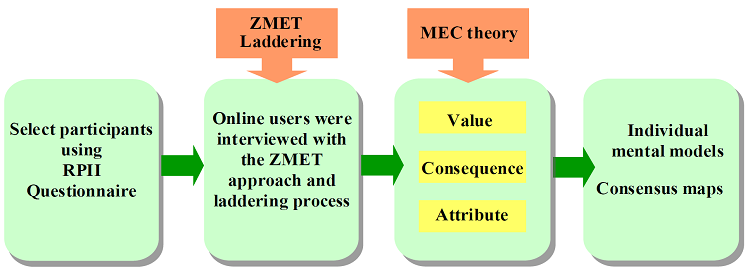Projecting the Mental Model of Social Networking Site Usage
Keywords:
social networking sites, projective technique, Zaltman metaphor elicitation technique, mental model, means-end chain theoryAbstract
The growth of online social networking sites (SNS) has created a new world of connection and communication for online users. SNS usage has become an important part of people’s daily lives. This study aims to obtain new insights towards SNS usage behaviour. Based on participants’ mental models, it is hoped to make more clear exposition about their perceptions and experiences as well as to explore what factors affect their behaviour for using social networking sites. A blend of qualitative methodologies was adopted for data collection and analysis, including the Zaltman metaphor elicitation technique (ZMET) method, the laddering technique, and the means-end chain theory. The results of this study show that the most important values of using SNS include its convenience, maintaining relationship, gaining relaxation, as well as reaching coherence. Additionally, participants pointed out they cared about their online privacy issues very much and had found some potential dangers; however, they continued to use these sites because of the great benefits and enjoyment.
References
Sean Casey, “The 2016 Nielsen social media report,” http://www.nielsen.com/us/en/insights/reports/2017/2016-nielsen-social-media-report.html, 2017.
Pew Research Center, “79% of online adults (68% of all Americans) use Facebook,” http://www.pewinternet.org/2016/11/11/social-media-update-2016/pi_2016-11-11_social-media-update_0-02/.
S. Jones and S. Fox, “Generations online in 2009,” http://www.pewinternet.org/’/media//Files/Reports/2009/PIP_Generations_2009.pdf, 2009.
K. C. Laudon and J. P. Laudon, Management information systems: managing the digital firm, New Jersey: Prentice-Hall, 2012.
A. Lenhart, K. Purcell, A. Smith, and K. Zickuhr, “Social media and young adults,” Washington, DC: Pew Internet and American Life Project, http://pewinternet.org/Reports/2010/Social-Media-and-Young-Adults.aspx, 2010.
The 2010 Nielsen Company report, “Global audience spends two hours more a month on social networks than last year,” http://blog.nielsen.com/nielsenwire/global/global-audience-spends-two-hours-more-a-month-on-social-networks-than-last-year/>, 2010.
J. Hahn, “Social networking ad spending to reach $2.6 billion,” http://www.emarketer.com/Article.aspx?id=1006278/.
P. Rydén, T. Ringberg, and R. Wilke, “An investigation of the mental models of social media in the minds of managers,” the 43rd EMAC Annual Conf. 2014, 2014, pp. 1-9.
G. Zaltman and R. Coulter, “Seeing the voice of the customer: Metaphor based advertising research,” Journal of the Marketing Research Society, vol. 35, no. 4, pp. 35-51, 1995.
G. Catchings-Castello, “The ZMET alternative,” Marketing Research, vol. 12, no. 2, p. 6, 2000.
G. Zaltman, “Eliciting mental models through imagery 22,” The Languages of the Brain, vol. 6, pp. 363, 2002.
A. G. Woodside, “Advancing means end chains by incorporating Heider’s balance theory and Fournier's consumer-brand relationship typology,” Psychology & Marketing, vol. 21, no. 4, pp. 279-294, March 2004.
M. Vriens and F. T. Hofstede, “Linking attributes, benefits, and consumer values,” Marketing Research, vol. 12, no. 3, pp. 4-10, 2000.
R. B. Woodruff and S. Gardial, Know your customer: New approaches to understanding customer value and satisfaction. Wiley, 1996.
G. L. Christensen and J. C. Olson, “Mapping consumers’ mental models with ZMET,” Psychology and Marketing, vol. 19, no. 6, pp. 477-502, May 2002.
T. J. Reynolds and J. Gutman, “Laddering theory, method, analysis, and interpretation,” Journal of advertising research, vol. 28, no. 1, pp. 11-31, March 1988.
D. Boyd and N. Ellison, “Social network sites: Definition, history, and scholarship,” Journal of Computer-Mediated Communication, vol. 13, no. 4, pp. 210-230, 2007.
R. Junco, “The relationship between frequency of Facebook use, participation in Facebook activities, and student engagement,” Computers & Education, vol. 58, no. 1, pp. 162-171, January 2012.
O. Kwon and Y. Wen, “An empirical study of the factors affecting social network service use,” Computers in Human Behavior, vol. 26, no. 2, pp. 254-263, March 2010.

Published
How to Cite
Issue
Section
License
Submission of a manuscript implies: that the work described has not been published before that it is not under consideration for publication elsewhere; that if and when the manuscript is accepted for publication. Authors can retain copyright in their articles with no restrictions. is accepted for publication. Authors can retain copyright of their article with no restrictions.
Since Jan. 01, 2019, AITI will publish new articles with Creative Commons Attribution Non-Commercial License, under The Creative Commons Attribution Non-Commercial 4.0 International (CC BY-NC 4.0) License.
The Creative Commons Attribution Non-Commercial (CC-BY-NC) License permits use, distribution and reproduction in any medium, provided the original work is properly cited and is not used for commercial purposes.



